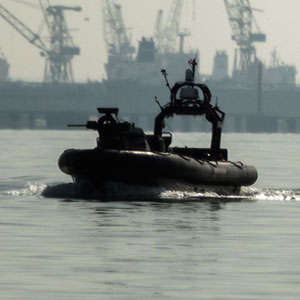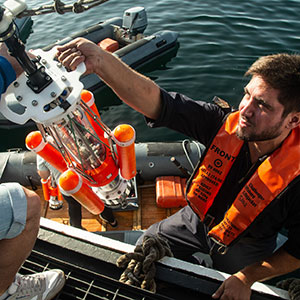Dozens of unmanned underwater, surface and air vehicles from NATO countries have gathered in Portugal for two weeks in September, testing new technological advances in unmanned maritime systems networks. To beef up its Port defense capability the Portuguese Navy invited IAI to bring its Drone-Guard C-UAS system that provided unprecedented situational awareness and drone defeat capability during the exercise.
The “Recognized Environmental Picture Atlantic” (REP) Maritime Unmanned Systems (MUS) 2019 Exercise – #REPMUS19 Exercise was held in the Sesimbra and Troia Peninsula area in the south of Lisbon. Ever since its first edition in 2010, REP tests innovative networked vehicle systems through large-scale experimentation and cooperation involving academia, industry and the naval operational community across the NATO alliance.
The exercise provided an opportunity to test the interoperability of aerial, and technologies and the procedures and tactics for Maritime Unmanned Systems used by NATO countries.
800 personnel from the Portuguese Navy, Belgium, Italy, Poland, Turkey, the United Kingdom, and the United States, and the NATO Centre for Maritime Research and Experimentation participated in the exercise, along with support from academia and industry.
New maritime unmanned systems technologies can be a game-changer in countering multiple threats in the maritime domain. Unmanned systems also become a major risk for navies, defense forces and authorities, which should be understood, and countered effectively. For the forces operating unmanned systems, operation under degraded Position Navigation Timing and Communications (PNT-C) communications conditions is mandatory in a challenging operational environment.
Some of these capabilities were provided at REP(MUS)19 by the latest generation of IAI Elta Systems Drone-Guard multi-layered counter-UAS system that was deployed there by the invitation of the Portuguese Navy. Drone Guard was evaluated by the Portuguese forces in parallel to the exercise, in line with the port defense challenge.
The system comprised of Elta’s ELM-2026B X-band radar that also integrates into a VSHORAD point-defense capability, the radar detects all types of aerial targets, from aircraft and drones to small, slow low-flying or hovering multirotor drones. The radar provides automatic identification of targets.
Passive COMINT-ELINT sensor provides a second detection layer, detecting drones by their characteristic emissions. The system can identify and differentiate between drones and other emitters, such as Wi-Fi hot spots, and identify specific drone types by their electronic signature. These sensors can detect a drone even before it takes off, providing an early warning on hostile intent. Drone Guard can also detect ‘silent’ autonomous drones that do not rely on communications or GPS for their operation since it monitors a wide frequency spectrum that may also detect the signals of sensors used for the vehicle’s autonomous flight.
A third layer is a visual identification by electro-optical (EO/IR) sensors providing positive identification of a drone target.
An active jammer integrated into the system enables operators to engage a target of choice or multiple targets. Due to the high efficiency of the system, Drone Guard jammer needs focuses its power at a narrow lobe to defeat targets at a significant range. Therefore, the system minimizes the transmitted power and interference to other systems.
All sensors were managed on a unified control unit, that tracked and engaged multiple targets during the exercise. The system tracked small drones and tactical UAS deployed against the port by Portuguese Navy commandos in day and night, from the sea and inland. Using automatic classification and identification, Drone Guard detected those drones at significant ranges and provided situational awareness and early warning operating in a challenging electromagnetic noisy environment involving aerial traffic and extensive communications activity.
The need for such capability became clear after the surprise attack on Saudi oil facilities. While air defense radars provide effective early warning from enemy aircraft, those radars often ignore targets flying very low or very slow since they masked in the ground clutter or filtered as birds. A Drone Guard system added to existing radars would enhance existing air defense radars, such as Elta’s MMR, to improve small, slow low (SSL) target detection.
The Drone Guard was set up to establish 360° coverage, to detect and simultaneously track high and low flying airborne threats over land and sea. Portuguese special forces launched a raid against the port, launching single drones and a swarm of drones against the target. These included mini UAS and multirotor drones as small as a Mavic-Pro quad. Controlled by the forces on rubber boats, the drones simultaneously attacked the harbor from both the land and sea. The Drone Guard effectively detected and tracked those targets at a long-range, automatically classified the threats and provided a situational picture in real-time. The system successfully intercepted and neutralized the drones through jamming and brought them to the ground.
Drone Guard comprises three detection layers, the radar and passive communications-electronic intelligence (COMINT-ELINT). With the integrated Electro-Optics sensor, Drone Guard provides multi-sensor, multi-spectral C-UAS capability to detect, identify and analyze drone targets. The combination of passive and active sensing systems enables the detection of drone activity, including drone swarm. “The Drone Guard system performed flawlessly during the event.” Abish Asher, Regional Director of Marketing and Sales at ELTA commented following the exercise. “The system provided an advance and innovative awareness display of integrated surface and air situation picture while simultaneously auto classifying different types of targets.”
“C-UAS units must be able to detect and classify both hostile as well as civilian drones that mistakenly enter sensitive areas as they too can cause unintended damage to a facility’s infrastructure,” Asher added, “The Drone Guard was successful in providing a protective dome around the harbor against the tested air threats. The Portuguese Navy expressed their appreciation and satisfaction with the results.”




























